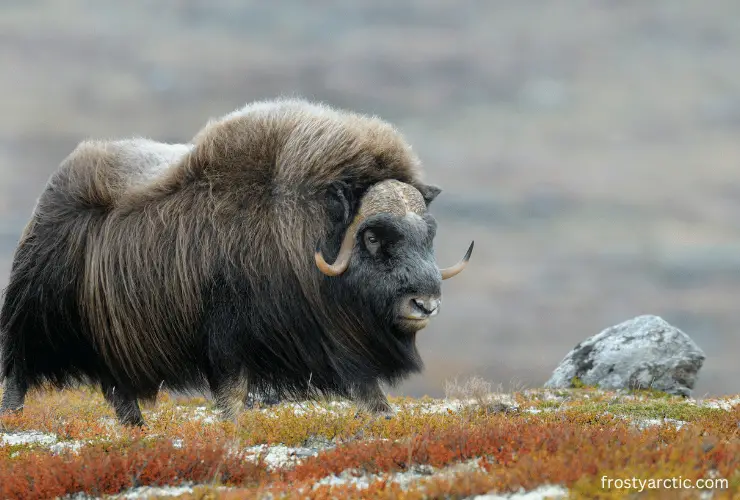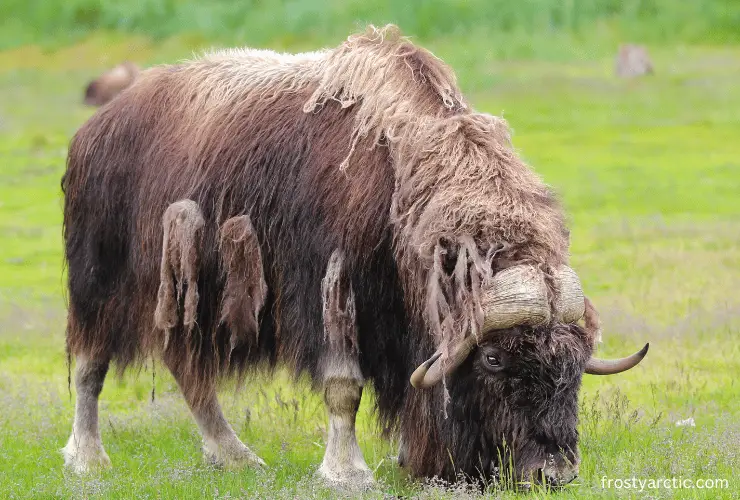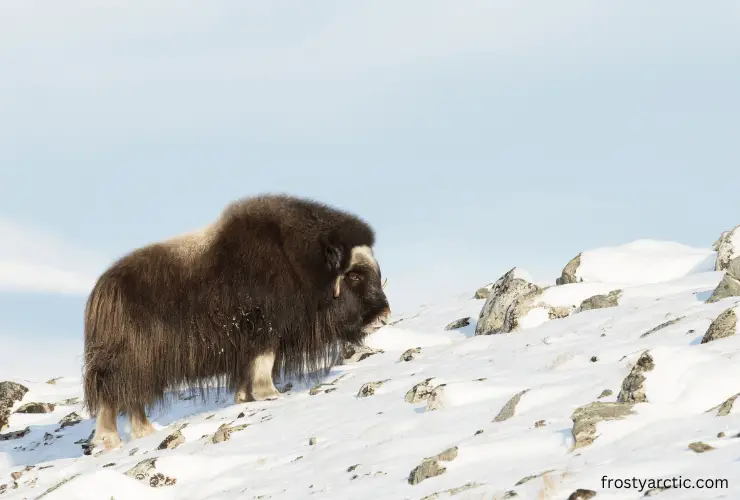Musk Oxen are herbivorous animals that feed primarily on the leaves and stems of low-growing plants in the Arctic Tundra. These include lichens, mosses, shrubs, willows, etc. However, they sometimes eat marine plants like seaweed and kelp, depending on food availability.
However, being herbivores, they don’t eat meat. They have a uniquely adapted digestive system that functions well to digest plant material, not meat.
Want to learn more about what Musk Oxen Eat and their appetite? Then dive to the next section, as this article covers all your mysterious quizzings!
What Do Musk Oxen Eat?
Musk Oxen are herbivores. They feed on low-growing plants and vegetation.
In zoology, they are categorized as herbivores that consume a folivorous and graminivores diet. These include:
- Lichens
- Mosses
- Crowberry
- Dwarf Birch
- Willows
- Sedges
- Labrador tea
- Bearberry
- Shrubs
- Fireweed
- Grasses
However, since digesting these hard materials is difficult, they often require a long digestive tract.
What Do Musk Oxen Eat in Winter?
In winter, only limited vegetation is available due to the harsh conditions of the Arctic Tundra.

These include regular lichens, mosses, and marine seaweeds.
So, Musk Oxen dig through the snow and eat them.
Moreover, they rely on the stored fat reserves to provide them necessary nutrition.
What Do Musk Oxen Eat in Summer?
In summer, due to the extensive availability of food, Musk Oxen have lots of options to choose from.

They primarily feed on leaves, shoots, and stems of various plant species, including:
- Willow
- Dryas
- Mosses
- Sedges
- Birch
- Lichens
- Forbes
Do Musk Oxen Eat Animals?
No!
Musk Oxen are herbivores. They don’t prey upon animals. Instead, they feed on land and marine plants.
Who Preys Upon Musk Oxen?
Since Musk Oxen are large animals with tight-knit social structures, predating and hunting them is difficult.
They have various adaptations to repel their predators and thus keep them from coming close.
Moreover, due to the large size of grown Musk Oxen, most predators prey upon small Musk Oxen, called calves.
Some of the known predators of Musk Oxen are:
Arctic Wolf
Arctic Wolves, just like Musk Oxen, live and travel in groups.
So, the herd of wolves attacks the Musk Oxen group and often separates one or two oxen from the group. Then they attack the oxen and succumb to bites.
Polar Bears
Apart from Arctic Wolf, polar bears also prey upon Musk Oxen.
However, these toxins are not the source of their primary food.
Instead, polar bears prefer to eat seals and other fishes. Moreover, they prefer to prey on young calves.
Golden Eagle
Similarly, golden eagles can take down small calves with their sharp talons and eat them.
In addition, humans also hunt Musk Oxen for their meat and fur.
Where its meat is extraordinarily lean and delicious, its skin is known for its warmth and softness.
How Do Musk Oxen Find Food?
In summer, many plants are grown on the arctic tundra; therefore, finding them has never been a difficult option.

However, in winter, these low-growing plants are often covered with layers of snow. Therefore, finding food requires a bit of effort.
So, the musk Oxen use their hooves for this purpose. The hooves help dig through the snow to access the low-growing plants.
Sometimes, they also use their incisors to scrape away snow and get food.
How Do Musk Oxen Digest Food? The Unique Digestive System
A unique, four-chambered digestive system is marked by the adaptations of Musk Oxen that helps them survive the harsh arctic climate.
It has a four-chambered stomach that helps digest plant material and extract all moisture. The four parts, along with their role, are:
Rumen
The first, and let me say, the largest chamber of the Musk Oxen digestive system, is the rumen.
It has a pool of microbes that helps ferment feed and extract multiple nutrients from them, later converting them into volatile fatty acids.
Reticulum
The second chamber is Reticulum. It traps the partially digested and hard materials from the rumen, which are regurgitated from the rumen.
Omasum
The third part is omasum. It has numerous leaf-like, multiple-fold tissues that help extract and absorb water.
Moreover, it digests the partially digested food coming from the rumen.
Abomasum
It is the fourth and the last chamber that functions much like that of humans.
It contains various enzymes and acids that aid in digesting and breaking down food, later moving it to the small intestine.
A few unique characteristics of their digestive system are:
- It consists of a large rumen that helps break down and digest the hard plant materials. That is why their rumen is known as a formatting section or vat.
- They have specialized stomachs like that of other grazing animals, including cows and sheep. It helps increase digestion efficiency.
- They have a lot of microbes in their body, including fungi, protozoa, and bacteria, that help them extract the necessary minerals from plants.
How Much Do Musk Oxen Eat in A Day?
A general observation is that a Musk Ox eats 4 to 9 kgs (9 to 20 pounds) of vegetation daily.
However, how much a Musk Oxen consumes daily varies depending on the external environment, age, size, etc.

For example, in winter, Musk Oxen reduce their appetite due to less availability of food. However, in the summer, Musk Oxen eat a lot.
How Do Musk Oxen Live Without Food?
Musk Oxen have undergone various adaptations that help them survive without food for a short period. These include:
Fat storage
These animals have stored a large hump of fat on their back.
This fat not only helps to conserve heat but also acts as a source of food and energy during extended periods of food scarcity.
Reducing Metabolism
Musk Oxen are also adapted to reduce their body metabolism by lowering their breathing rates, heartbeat, and rate of burning it.
In this way, the overall expenditure of energy is reduced.
Moreover, they reduce their daily life activities, live in groups called herds, conserve water, and extract moisture.
All these are the key adaptations that help these herding animals survive food shortages in winter.
Can Musk Oxen Feed on Marine Plants?
Yes!
Musk Oxen feed on marine plants occasionally. They prefer to eat land-based plants.
However, in winter, due to a food shortage and when near the coastal area, Musk Oxen are known to feed on several marine plants.
These include various seaweeds, kelps, algae, and eelgrass.
Frequently Asked Questions
Q.1 Can humans eat Musk Oxen?
Yes! Humans eat Musk Oxen, and their digestive system is strong enough to digest it properly. The meat of Musk Oxen is a rich source of vitamin B, iron, and protein.
However, it is considered one of the gourmet delicacies, thus being quite expensive.
Q.2 How many stomachs do Musk Oxen have?
Musk Oxen have one stomach. However, since oxen are ruminants, their stomach is divided into four parts or chambers that help digest grasses and other plants quickly. The four parts are:
- Rumen
- Reticulum
- Omasum
- Abomasum
Q.3 Do Musk Oxen Eat Meat?
No!
Musk Oxen don’t eat meat. Their unique digestive system digests plant fibers and not animal proteins.
Final Verdict
Musk Oxen are herbivores. Therefore, they have a pure folivorous, graminivorous diet based on stems, leaves, and shoots of low-growing plants of the Arctic Tundra.
They have a unique four-chambered digestive system to digest the hard woody material and plant fibers. However, they don’t digest meat.



3 thoughts on “What Do Musk Oxen Eat?”